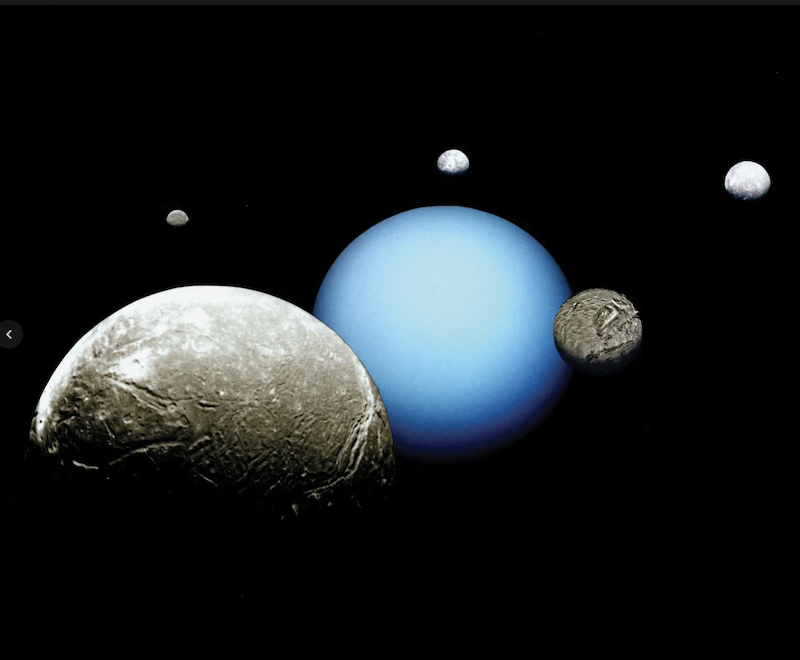3 new-found moons for Uranus and Neptune
Like their larger siblings Jupiter and Saturn, the ice giants Uranus and Neptune have many moons. And now we can add three new-found moons to the list, bringing the totals to 28 known moons for Uranus and 16 known moons for Neptune. Carnegie Science in Pittsburgh, Pennsylvania, issued a press release about the new moons on February 23, 2024. They said Uranus has one newly discovered moon. And Neptune has two. All three are the faintest yet discovered with ground-based telescopes to be orbiting the two giant worlds in the outer solar system.
How ever did the astronomers spot the new moons?
EarthSky lunar calendars are back in stock! And we’re guaranteed to sell out, so get one while you can. Your support means the world to us and allows us to keep going. Purchase here.
Spotting faint moons from Earth’s surface
The three newly discovered moons are the faintest yet found for Uranus and Neptune using Earth-based telescopes. How did astronomers spot them? Scott Sheppard at Carnegie Science said:
It took special image processing to reveal such faint objects.
These astronomers captured dozens of 5-minute exposures of the vicinity around Uranus and Neptune, over three- or four-hour periods, and over a series of nights. As Sheppard explained:
Because the moons move in just a few minutes relative to the background stars and galaxies, single long exposures are not ideal for capturing deep images of moving objects. [But] by layering these multiple exposures together, stars and galaxies appear with trails behind them, and objects in motion similar to the host planet will be seen as point sources. So the moons stand out from behind the background noise in the images.
IAU Circulars here
The International Astronomical Union’s Minor Planet Center in Massachusetts made the original announcements of the new discoveries:
Meet the new moons
The new Uranus moon provisionally has the name S/2023 U1. It’s only about 5 miles (8 km) in actual size, which gives you a clue to the momentousness of this feat of discovery, given that Uranus is located about 2 billion miles (3.2 billion km) from Earth.
The new moon takes some 680 days to orbit once around Uranus.
Sheppard and his colleagues first detected this new Uranus moon on November 4, 2023, using the Magellan Telescopes at Carnegie Science’s Las Campanas Observatory in Chile. Follow-up observations in December confirmed the discovery. The researchers also subsequently found it in older images from 2021, from both Magellan and the Subaru Telescope in Hawaii.
Finding more new moons
Sheppard also used the Magellan Telescopes to find the brighter of Neptune’s two new moons. It has the provisional name S/2002 N5. It is about 14 miles (23 km) across and orbits Neptune in nine years. S/2002 N5 also appeared seen in older images, but not confirmed. Sheppard said:
Once S/2002 N5’s orbit around Neptune was determined using the 2021, 2022, and 2023 observations, it was traced back to an object that was spotted near Neptune in 2003 but lost before it could be confirmed as orbiting the planet.
The second smaller and fainter of Neptune’s new moons is called S/2021 N1. It is nine miles (14 km) across and orbits Neptune every 27 years.
Later, both of the new Neptune moons will receive new names based on the 50 Nereid sea goddesses in Greek mythology. The Nereids were the daughters of Doris, the mythological Okeanid-nymph wife of the sea-god Nereus.

Eccentric, dynamical orbits
All three of the newly confirmed moons have eccentric, inclined orbits. Scientists say their orbits are an indication that these little moons weren’t born with Uranus and Neptune. Instead, they are captured worlds, probably snagged by the gravity of the ice giants shortly after the planets first formed. As Sheppard noted:
Even Uranus, which is tipped on its side, has a similar moon population to the other giant planets orbiting our sun. And Neptune, which likely captured the distant Kuiper Belt object Triton – an ice-rich body larger than Pluto – an event that could have disrupted its moon system, has outer moons that appear similar to its neighbors.
The orbits of the new Uranus and Neptune moons are also what scientists call dynamical orbital groupings of outer moons. For example, at Uranus, S/2023 U1 has a similar orbit to the moons Caliban and Stephano. Meanwhile, at Neptune, S/2021 N1 has a similar orbit to Psamathe and Neso, and S/2002 N5 has a similar orbit as Sao and Laomedeia.
Essentially, these groupings resulted from larger former moons breaking up in collisions with comets or asteroids. In fact, the fragments – the tiny smaller moons – are thought to maintain similar orbits to the original big moon.
This discovery also prompts the question of how many other similar moons may be waiting to be discovered in the outer solar system.
Bottom line: The number of known Uranus and Neptune moons just grew by three, astronomers said on Friday. The newly discovered moons are the faintest ever found so far by Earth-based telescopes.
Via Carnegie Science
Read more: New Uranus images showcase rings, moons … and galaxies
Read more: Why are Uranus and Neptune different colors?